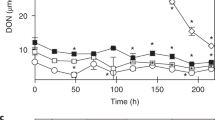Summary
When ice samples are melted, microorganisms living within the brine inclusions are subjected to rapid and extreme changes in salinities. This procedure results in substantial losses of flagellates and ciliates. Most of these losses can be prevented if ice samples are melted in larger volumes of sterile sea water to buffer salinity and osmotic changes. Since most studies on the ice biota have ignored, or have been unable to avoid this bias, current views of the composition and activity of sea ice communities are based on assemblages over-representing organisms with rigid cell material.
Similar content being viewed by others
References
Assur A (1985) Composition of sea ice and its tensile strength. In: Arctic sea ice. National Academy of Sciences, National Research Council Publ 598, Washington DC, pp 106–138
Beers JR, Stewart GL (1970) Numerical abundance and estimated biomass of microzooplankton. In: Strickland JDH (ed) The ecology of plankton off La Jolla, California, in the period April through September 1967. University of California Press, Berkeley, pp 67–87
Dale T, Burkill PH (1982) Live Counting — a quick and simple technique for enumerating pelagic ciliates. Ann Inst Oceanogr, Paris 58:267–776
Eppley RW, Reid FM, Strickland JDH (1970) Estimates of phytoplankton crop size, growth rate, and primary production. In: Strickland JDH (ed) The ecology of plankton off La Jolla, California, in the period April through September 1967. University of California Press, Berkeley, pp 33–42
Garrison DL, Sullivan CW, Ackley SF (1986) Seaice microbial communities in antarctica. Bioscience 36:243–250
Gifford DJ (1985) Laboratory culture of marine planktonic oligotrichs (Ciliophora, Oligotrichida). Mar Ecol Prog Ser 23:257–267
Hewes, CD, Reid FMH, Holm-Hansen O (1984) The quantitative analysis of nanoplankton: a study of methods. J Plankton Res 6:601–613
Horner RA (1985a) A history of ice algal investigations In: Horner RA (ed) Ice biota. CRC Press, Boca Raton Fla, pp 1–19
Horner RA (1985b) Ecology of sea ice microalgae. In: Horner RA (ed) Ice biota. CRC Press, Boca Raton Fla, pp 83–103
Palmisano AC, Sullivan CW (1985) Growth, metabolism, and dark survival in sea ice microalgae. In: Horner R (ed) Ice biota, CRC Press, Boca Raton Fla, pp 131–146
SorokinYu I (1981) Microheterotrophic organisms in marine ecosystems. In: Longhurst AR (ed) Analysis of marine ecosystems. Academic Press, London, pp 293–342
Utermöhl H (1931) Neue Wege in der quantitativen Erfassung des Planktons. Verh Int Ver Theor Angew Limnol 5:567–595
Weeks WF, Ackley SF (1982) The growth, structure, and properties of sea ice. CRREL Monogr 82-1
Author information
Authors and Affiliations
Rights and permissions
About this article
Cite this article
Garrison, D.L., Buck, K.R. Organism losses during ice melting: A serious bias in sea ice community studies. Polar Biol 6, 237–239 (1986). https://doi.org/10.1007/BF00443401
Received:
Accepted:
Issue Date:
DOI: https://doi.org/10.1007/BF00443401




